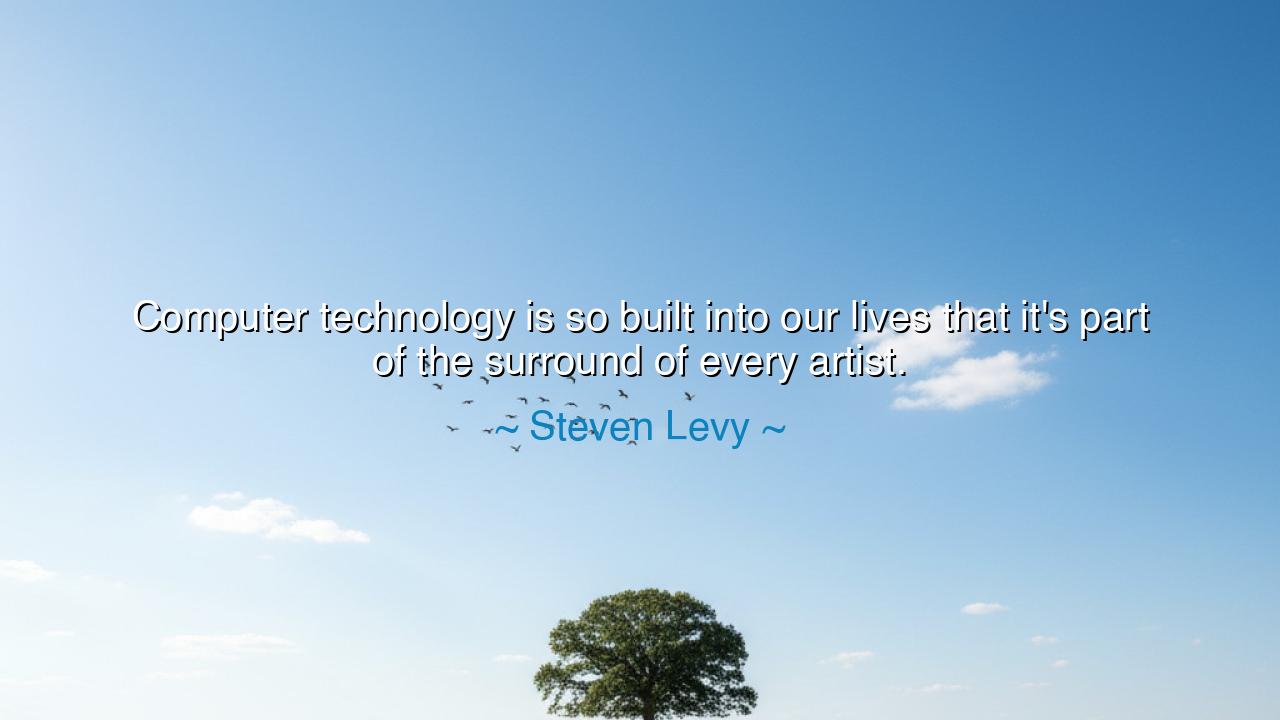
Computer technology is so built into our lives that it's part of
Computer technology is so built into our lives that it's part of the surround of every artist.






The words of Steven Levy, “Computer technology is so built into our lives that it's part of the surround of every artist,” resound like the tolling of a bell that marks the passage from one age into another. In these words, the chronicler of the digital revolution reminds us that computer technology is no longer a tool at the edge of creation, but part of the very air that modern creators breathe. It is the surround, the environment, the horizon against which every artist now stands, whether they embrace it or resist it. Just as stone and pigment once defined the works of ancient masters, so too circuits, algorithms, and networks define the canvas of today.
The origin of Levy’s saying lies in his lifelong study of hackers, programmers, and visionaries—the men and women who built the frameworks of the digital age. In his book Hackers and later works, he traced how computing moved from hidden laboratories into the homes, studios, and pockets of ordinary people. By the turn of the millennium, computers had ceased to be specialized tools; they had become the background against which all human activity unfolded. For artists, this meant that their work, whether painting, music, film, or literature, was inevitably touched by the presence of the digital. Even if they chose not to use it directly, their audience consumed their art through screens, files, and networks.
History gives us parallels in earlier ages. When printing technology first spread, it forever changed the artist’s relationship to words and images. The poet could now reach thousands instead of a handful of listeners; the engraver’s work could be multiplied across nations. The medium became the environment, just as it is today with computers. Likewise, the invention of the camera changed the very way painters approached reality: no longer was painting merely about faithful depiction, but about interpretation and style. Each new technology reshaped the surround of the artist, altering both what could be made and how it would be seen.
The deeper meaning of Levy’s words is that artists do not create in isolation. They create within an environment shaped by the tools, media, and expectations of their time. Today, the painter may still hold a brush, but their work will likely be photographed, digitized, and shared online. The musician may still strum a guitar, but the sound is shaped by software, stored in digital formats, and streamed across continents. Even the poet’s voice, once bound to parchment, is now whispered into microphones and distributed across platforms. Thus, computer technology is not optional—it is the atmosphere of modern creation.
Yet there is both power and peril here. For while technology expands possibility, it also threatens to drown the artist in distraction, imitation, or overreliance. The true master does not surrender their voice to the machine, but uses the machine to amplify their voice. Just as a sculptor must master stone and not be mastered by it, so too must today’s artist master the digital without being consumed by it. This is the heroic challenge of the age: to remain authentic amidst the vast chorus of technological noise.
For those who live now, the lesson is clear: embrace the surround, but do not lose yourself in it. Learn the tools of your time, but let them serve your spirit rather than replace it. Recognize that your audience lives in the digital, and so your art must travel there, yet anchor your creativity in truth deeper than any algorithm. Just as past generations used presses, cameras, and microphones to carry their voices farther, so too must you use computer technology—but with wisdom, discipline, and soul.
So let this teaching be carried forward: every artist creates within a surround, and in our age, that surround is digital. Do not fear it, and do not idolize it. Instead, treat it as you would the air you breathe—necessary, omnipresent, but invisible compared to the light of your spirit. For though technology frames your work, it is your vision, your heart, and your truth that will endure when all circuits fall silent.






AAdministratorAdministrator
Welcome, honored guests. Please leave a comment, we will respond soon